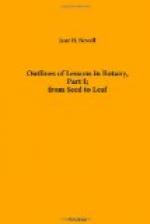The author will receive gladly any criticisms or suggestions.
Jane H. Newell.
175 Brattle St., Cambridge
INTRODUCTION.
The lessons here outlined are suitable for children of twelve years of age, and upwards. For younger pupils they would require much adaptation, and even then they would not be so good as some simpler method, such as following the growth of one plant, and comparing it with others at every step. The little ones profit most by describing the very simple things that they see, without much reference to theories.
The outlines follow the plan of Dr. Gray’s First Lessons and How Plants Grow, and are intended to be used in connection with either of those books. The necessary references will be found at the end of every section. The book contains also references to a course of interesting reading in connection with the subjects of the lessons.
The lessons may begin, like the text-books, with the subject of Germination, if the seeds are planted before they are required for use, but it is generally preferable to use the first recitation with the class for planting the seeds, in order to have them under the direct care of the pupils. Some general talks about plants are therefore put at the beginning to occupy the time until the seedlings are ready for study.
Some Nasturtiums (Tropaeolum majus) and Morning-Glories should be planted from the first in boxes of earth and allowed to grow over the window, as they are often used for illustrations.
I.
Plants and their uses.[1]
[Footnote 1: This section may be omitted, and the lessons begun with Seedlings, if the teacher prefer.]
What is Botany? The pupils are very apt to say at first that it is learning about flowers. The teacher can draw their attention to the fact that flowers are only a part of the plant, and that Botany is also the study of the leaves, the stem, and the root. Botany is the science of plants. Ask them what the Geranium is. Tell them to name some other plants. The teacher should keep a few growing plants in the schoolroom for purposes of illustration.
Ask them what else there is in the world besides plants. By this question the three kingdoms, animal, vegetable, and mineral, are brought up. It will give occasion for a discussion of the earth and what it contains, the mountains, formed of rocks and soil, the plants growing on the earth, and the animals that inhabit it, including man. Let them name the three kingdoms with some example of each. Which of these kingdoms contain living things? The words organic and inorganic can be brought in here. An organ ([Greek: Ergon], meaning work) is any part that does a special work, as the leaves, the stem of a plant, and the eye, the ear of animals. An organism is a living being made up of such organs. The inorganic world contains the mineral kingdom; the organic world includes the vegetable and animal kingdoms.




